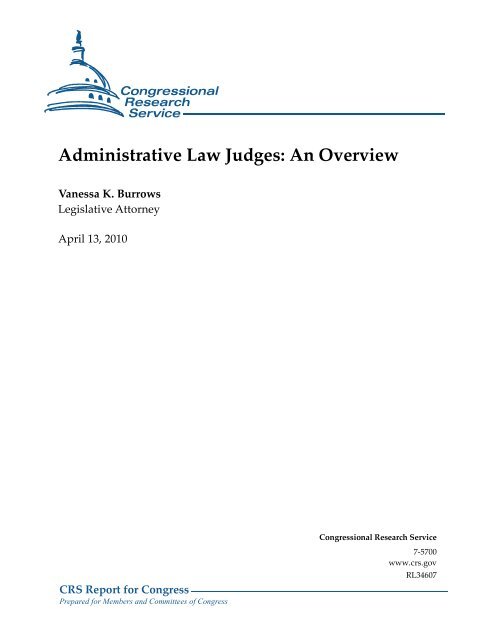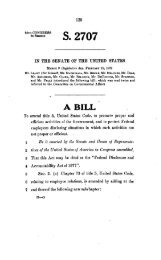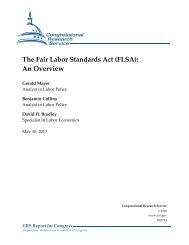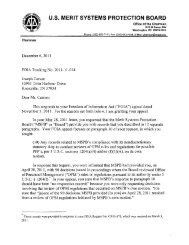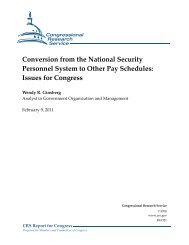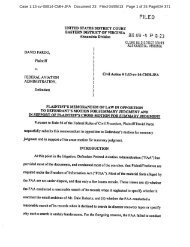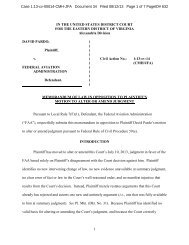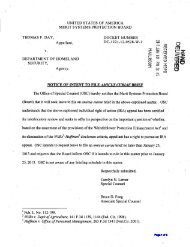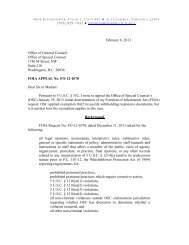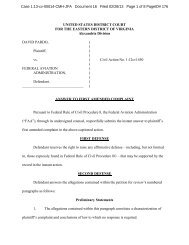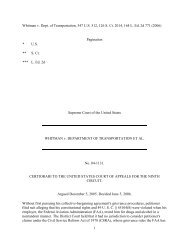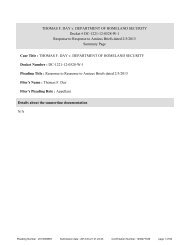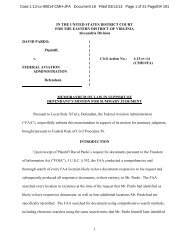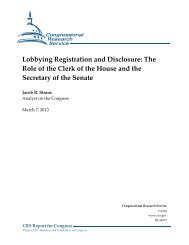Administrative Law Judges: An Overview - MSPB Watch
Administrative Law Judges: An Overview - MSPB Watch
Administrative Law Judges: An Overview - MSPB Watch
Create successful ePaper yourself
Turn your PDF publications into a flip-book with our unique Google optimized e-Paper software.
<strong>Administrative</strong> <strong>Law</strong> <strong>Judges</strong>: <strong>An</strong> <strong>Overview</strong>Vanessa K. BurrowsLegislative AttorneyApril 13, 2010Congressional Research ServiceCRS Report for CongressPrepared for Members and Committees of Congress7-5700www.crs.govRL34607
<strong>Administrative</strong> <strong>Law</strong> <strong>Judges</strong>: <strong>An</strong> <strong>Overview</strong>Summary<strong>Administrative</strong> law judges (ALJs) preside at formal adjudicatory and rulemaking proceedingsconducted by executive branch agencies. ALJs make decisions in these proceedings, and theiradministrative determinations must be based on the record of trial-type hearings. <strong>An</strong> ALJ’sfunction as an independent, impartial trier of fact in agency hearings is comparable to the role of atrial judge presiding over non-jury civil proceedings. Although there are many ALJs working instate government, this report describes the role of federal ALJs, with a specific focus on themission, responsibilities, and appointment of such ALJs. This report also discusses the differencesbetween ALJs and non-ALJ hearing examiners who conduct administrative adjudication infederal agencies.In the 111 th Congress, several bills have been introduced regarding ALJs, including H.R. 2850, S.372, and S. 1228.Congressional Research Service
<strong>Administrative</strong> <strong>Law</strong> <strong>Judges</strong>: <strong>An</strong> <strong>Overview</strong>ContentsIntroduction ................................................................................................................................1Hiring and Appointment of ALJs.................................................................................................2Selective Certification...........................................................................................................4ALJ Independence and Performance Evaluations ........................................................................7ALJ Removal, Productivity, and Discipline .................................................................................8Adjudication by ALJs and Non-ALJ Hearing Officers .................................................................9ContactsAuthor Contact Information ......................................................................................................11Congressional Research Service
<strong>Administrative</strong> <strong>Law</strong> <strong>Judges</strong>: <strong>An</strong> <strong>Overview</strong>IntroductionThe <strong>Administrative</strong> Procedure Act (APA) was enacted in 1946 to ensure fairness and due processin executive agency actions or proceedings involving rulemaking and adjudications. 1 In pursuit ofthis goal, the APA created the position of the <strong>Administrative</strong> <strong>Law</strong> Judge (ALJ) within the federalgovernment. ALJs were originally called hearing examiners, and the APA established certainprotections to preserve the independence of these hearing officers. 2 Because ALJs are employeesof federal agencies, one of the primary goals behind the creation of the position of ALJs was toensure that such hearing officers are able to conduct trial-like hearings free from agency coercionor influence.To the extent that the APA or other relevant laws are applicable, parties in agency proceedings areafforded protections that include, among other things, a hearing on the record with an impartialpresiding officer. 3 The APA provides that when a statute requires an agency adjudication to bedetermined on the record, an ALJ or the agency head must preside. 4 The subject matter of thehearing or proceeding varies among the agencies and includes disability determinations as well aslicensing, sanctions, and civil penalty determinations.In general, ALJs have two primary duties in the administrative adjudication process. The firstduty is to preside over the taking of evidence at agency hearings and act as the finder of facts inthe proceedings. In support of this duty, ALJs are authorized to regulate the course of the hearing,issue subpoenas, rule on offers of proof and receive relevant evidence, take depositions or havedepositions taken, hold settlement conferences, rule on procedural requests, question witnesses,and make findings of fact and conclusions of law. 5 <strong>An</strong> ALJ’s other main duty is to act as adecisionmaker by making or recommending an initial determination about the resolution of thedispute. 6 In all of these regards, ALJs, who are executive branch employees, function much liketrial judges in the judicial branch.1 5 U.S.C. §§ 551 et seq.2 In 1978, Congress changed the title “hearing examiners” to “<strong>Administrative</strong> <strong>Law</strong> <strong>Judges</strong>.” P.L. 95-251, 92 Stat. 183(1978) (amending 5 U.S.C. §§ 554(a)(2), 556(b)(3), 559, 1305, 3344, 4301, 5335, 5362, 7251).3 The APA excludes certain proceedings, such as those where decisions rest solely on inspections, tests, or elections. 5U.S.C. § 554(a)(1)-(6). Requirements regarding “on the record” hearings are set forth at 5 U.S.C. §§ 554. The APAprovisions that govern hearings, presiding officers, evidence, and the content of decisions are set forth at 5 U.S.C. §§556 and 557.4 5 U.S.C. §§ 554, 556-557. If the agency head presides, his or her decision is a final order, subject to judicial review.However, “[a]gency heads seldom have the time to preside.” Harold Levinson, The Status of the <strong>Administrative</strong> Judge,38 AM. J. OF COMP. LAW 523, 526 (1990).5 5 U.S.C. § 556.6 The initial decision of the ALJ becomes the final decision of the agency if it is not appealed by the parties or if theagency itself does not seek to review the case on its own motion. Id. at § 557(b). The agency’s decision, either adoptingthe ALJ’s decision or reversing it, is administratively final and subject to review in federal court. Id. at § 704.Congressional Research Service 1
<strong>Administrative</strong> <strong>Law</strong> <strong>Judges</strong>: <strong>An</strong> <strong>Overview</strong>Hiring and Appointment of ALJsAccording to the Office of Personnel Management (OPM), there were 1,422 ALJs assigned to 30federal agencies as of March 2009. 7 Of these, the agency that hires by far the most number ofALJs is the Social Security Administration (SSA). 8 Although the federal agency itself hires itsALJs, 9 OPM “has been exclusively responsible for the initial examination, certification forselection, and compensation of ALJs.” 10 ALJs are selected through a merit selection process thatis administered by OPM and advertised on the federal government’s job listing site,http://usajobs.opm.gov. 11 Under this process, OPM periodically conducts competitiveexaminations and uses the results of these examinations to rank applicants for ALJ positionsaccording to their qualifications and skills. 12 Under 5 U.S.C. § 3105, agencies are authorized toappoint as many ALJs as necessary for agency proceedings that are required to be on the record. 13The qualification standard for ALJ positions prescribes minimum requirements for ALJpositions. 14 Applicants must be licensed attorneys “authorized to practice law under the laws of aState, the District of Columbia, the Commonwealth of Puerto Rico, or any territorial court,” whohave a minimum of seven years of “experience as a licensed attorney preparing for, participatingin, and/or reviewing formal hearings or trials involving litigation and/or administrative law at theFederal, State, or local level.” 15 Applicants who meet these minimum qualification standards andpass the examination are then assigned a score and placed on a register of eligible hires. 16 Underthe regulations, applicants who receive a passing score are entitled to five to ten preference pointsif they are veterans. 17 Agencies then select an ALJ from the top three available candidates, taking7 Press Release, OPM, OPM to <strong>An</strong>nounce Opening of <strong>Administrative</strong> <strong>Law</strong> Judge Exam (Oct. 28, 2009).8 Even though the Social Security Administration (SSA) is the federal agency that employs the largest number of ALJs,the statute that governs the agency does not expressly require the use of ALJs in the administrative process; does notexpressly make applicable the adjudication sections of the APA to these hearings; and does not require a hearing “onthe record.” 42 U.S.C. § 405(b). Nevertheless, SSA has used ALJs for decades, “even though the APA on-the-recordhearing requirements may not have required it to do so.” PAUL R. VERKUIL ET AL., ADMINISTRATIVE CONFERENCE OFTHE UNITED STATES, RECOMMENDATIONS AND REPORTS, VOLUME II, at 791 (1992) (hereinafter ACUS 1992). The SSAhas promulgated regulations that provide persons dissatisfied with the agency’s decisions or determinations theopportunity to request a hearing before an ALJ. 20 C.F.R. § 404.929. See generally 20 C.F.R. Part 404.9 5 C.F.R. § 930.201(f).10 Jeffrey S. Lubbers, Federal <strong>Administrative</strong> <strong>Law</strong> <strong>Judges</strong>: A Focus on Our Invisible Judiciary, 33 ADMIN. L. REV. 109,112 (1981). See generally 5 U.S.C. § 3301. The American Bar Association House of Delegates has adopted a resolution“encourag[ing] Congress to establish The <strong>Administrative</strong> <strong>Law</strong> Judge Conference of the United States as an independentagency to assume the responsibility of [OPM] with respect to [ALJs] including their testing, selection, andappointment.” Recommendation Adopted August 8-9, 2005, http://www.abanet.org/leadership/2005/annual/dailyjournal/106a.doc.11 5 U.S.C. § 1302.12 “Except as otherwise provided in this chapter, each applicant who meets the minimum requirements for entrance toan examination and is rated 70 or more in the examination is eligible for appointment.” 5 C.F.R. § 337.101(a).13 See also 5 C.F.R. § 930.201(f)(1).14 Examining System and Programs for Specific Positions and Examinations (Miscellaneous), 72 Fed. Reg. 12947,12952 (Mar. 20, 2007). This qualification standard was issued on April 20, 2007, the day after the effective date ofOPM’s March 20, 2007, final regulations that updated the ALJ selection process. See Memorandum from Linda M.Springer, Director, OPM, to Chief Human Capital Officers, Issuance of Final Regulations and Qualification Standardfor <strong>Administrative</strong> <strong>Law</strong> Judge Program (Apr. 2, 2007), http://www.chcoc.opm.gov/transmittal_detail.cfm?ID=829.15 OPM, Qualification Standard for <strong>Administrative</strong> <strong>Law</strong> Judge Positions, http://www.opm.gov/qualifications/alj/alj.asp.16 Id.17 5 C.F.R. at § 930.203(e).Congressional Research Service 2
<strong>Administrative</strong> <strong>Law</strong> <strong>Judges</strong>: <strong>An</strong> <strong>Overview</strong>into account the location of the position, the geographical preference of the candidate, andveterans’ preference rules. 18 Although ALJs are generally hired by specific agencies, they can betransferred or detailed to another agency to hear cases if necessary, and if OPM approves. 19The preference criterion for veterans led to a long-running lawsuit and caused OPM totemporarily suspend the ALJ hiring process for a period of over four years, from 1999 to 2003.The litigation arose out of changes that OPM made in 1996 to the scoring formula that is used torate and rank potential ALJs. These changes, which did not conform to existing regulations butwhich OPM approved pursuant to its authority to issue variances from the regulations, resulted ina scoring system that assigned proportionally greater weight to the veteran’s preference than theprevious system had, thus giving veterans a significant hiring advantage over non-veterans. As aconsequence, non-veteran applicants for ALJ positions sued, claiming that the new scoringformula was unlawful. Although the Merit Systems Protection Board (<strong>MSPB</strong>) found that thescoring formula violated OPM regulations and the Veteran’s Preference Act and ordered OPM tosuspend use of the formula, 20 the United States Court of Appeals for the Federal Circuiteventually overturned the <strong>MSPB</strong> decision, holding that the <strong>MSPB</strong> did not have jurisdiction toreview the Veteran’s Preference Act claim and that the new scoring formula did not violate OPMregulations. 21As a result of the court decision, OPM resumed use of the 1996 scoring formula in 2003, but theagency did not accept new applications at that time because it planned to hire new ALJs from thepool of available applicants who qualified prior to the lawsuit. OPM had worked to develop anew ALJ examination that would replace the old one. As part of the move to update the ALJselection process, OPM issued a final rule in 2007 that, among other things, (1) eliminated thedetailed regulations describing the ALJ examination process; (2) required an active barmembership or current state license to practice law; 22 (3) disallowed an agency’s grant of amonetary or honorary award to an ALJ for any “superior accomplishment,” so as to maintain ALJindependence; and (4) revised ALJ pay to allow an agency to reduce an ALJ’s pay for good causeafter a disciplinary proceeding or based on an ALJ’s voluntary request for personal reasons. 23OPM created the pay reduction procedure because it “periodically receives [such] requests fromagencies” due to “the [ALJ’s] desire for a position of less responsibility.” 24According to OPM, the elimination of the regulations describing the ALJ examination processwill provide OPM with the flexibility to adopt, via the online job vacancy announcement on theUSAJOBS website, periodic changes in the ALJ examination process. The Association of<strong>Administrative</strong> <strong>Law</strong> <strong>Judges</strong>, seven ALJs, and three private practice attorneys filed suit under theAPA against OPM regarding the final rule with regard to the requirements that ALJs have active18 OPM, <strong>Administrative</strong> <strong>Law</strong> <strong>Judges</strong>, http://www.usajobs.opm.gov/ei28.asp.19 5 C.F.R. §§ 930.201, 930.204, 930.208.20 Azdell v. Office of Pers. Mgmt., 87 M.S.P.R. 133 (2000).21 Meeker v. Merit Sys. Prot. Bd., 319 F.3d 1368 (Fed. Cir. 2003), cert. denied, Azdell v. James, 540 U.S. 1218 (2004).22 In 2008, OPM suspended the requirement in 5 C.F.R. § 930.204(b) that incumbent ALJs, but not applicants for ALJpositions, have a current license to practice law, or have active or judicial status, or be in good standing to practice law.73 Fed. Reg. 41235, 41236 (July 18, 2008). OPM stated that it intended to seek comments on such a requirement in anew rulemaking and cited concerns from incumbent ALJs about their compliance with state bar or continuing legaleducation requirements. Id.23 Examining System and Programs for Specific Positions and Examinations (Miscellaneous), 72 Fed. Reg. 12947(Mar. 20, 2007).24 Id. at 12952; see 5 C.F.R. § 930.205(j).Congressional Research Service 3
<strong>Administrative</strong> <strong>Law</strong> <strong>Judges</strong>: <strong>An</strong> <strong>Overview</strong>bar membership or a current state license to practice law and with regard to OPM’s qualificationstandard, advance notice to federal agencies of the vacancy announcement’s posting, and thenumber of applications allowed to be filed before a cutoff number was reached. 25 After OPMissued an interim rule suspending the requirement in the final rule that incumbent ALJs, but notapplicants for ALJ positions, have a current license to practice law, or have active or judicialstatus, or be in good standing to practice law, the district court stayed the relevant parts of thecase. 26 The court granted summary judgment in favor of OPM on the other claims, finding thatthe plaintiffs lacked standing to challenge the qualification standard, that OPM’s notice was not afinal agency action subject to judicial review, and that the cutoff number for applications was notarbitrary or capricious. 27The ALJ application process remained closed until OPM issued a vacancy announcement forALJs on May 4, 2007, which closed a few days later after it reached a cutoff number of 1,250applicants. 28 Individuals who remained on the previous ALJ register were required to reapply ifthey still wished to be considered for an ALJ position. 29 On October 30, 2007, OPM announcedthat it had established a new register for filling open ALJ positions, which was based on the May2007 vacancy announcement. 30 At least one agency has already hired from this register. 31 OPMhas reopened the ALJ register several times since then. 32Selective CertificationIn the past, several agencies used the controversial concept of selective certification “to avoid therestrictions upon their appointment of ALJs.” 33 Under selective certification, “an agency, upon ashowing of necessity and with the prior approval of OPM, [would be] permitted to appoint25 Association of <strong>Administrative</strong> <strong>Law</strong> <strong>Judges</strong> v. United States Office of Personnel Management, No. 07-0711 (thirdamended complaint D.D.C.), at 1. The court dismissed, without prejudice, a complaint that the rule is inconsistent withthe statute’s plain language. Association of <strong>Administrative</strong> <strong>Law</strong> <strong>Judges</strong> v. United States Office of PersonnelManagement, No. 07-0711 (Order, Feb. 7, 2008, D.D.C.).26 Association of <strong>Administrative</strong> <strong>Law</strong> <strong>Judges</strong> v. United States Office of Personnel Management, No. 07-0711 (MinuteOrder, July 30, 2008, D.D.C.).27 Association of <strong>Administrative</strong> <strong>Law</strong> <strong>Judges</strong> v. United States Office of Personnel Management, 640 F. Supp. 2d 66,67-68 (D.D.C. 2009).28 The announcement specified that it would close May 18, 2007, or after the receipt of 1250 applicants. OPM,<strong>Administrative</strong> <strong>Law</strong> <strong>Judges</strong>, http://www.usajobs.opm.gov/ei28.asp.29 OPM, <strong>Administrative</strong> <strong>Law</strong> <strong>Judges</strong> (Jan. 9, 2006), http://www.usajobs.opm.gov/EI28.asp.30 Memorandum from Linda M. Springer, Director, OPM, to Chief Human Capital Officers, New <strong>Administrative</strong> <strong>Law</strong>Judge Register (Oct. 30, 2007).31 SSA, Press Release, Social Security Offers Positions to 144 <strong>Administrative</strong> <strong>Law</strong> <strong>Judges</strong> (Feb. 26, 2008),http://www.socialsecurity.gov/pressoffice/pr/ALJ-hiringpr.pdf.32 The ALJ register reopened on July 30, 2008, and OPM noted that the job announcement would remain open untilAugust 13, 2008, or the receipt of the 600 th completed application. The announcement had already closed to the receiptof applications by August 1, 2008. OPM, <strong>Administrative</strong> <strong>Law</strong> <strong>Judges</strong> (August 1, 2008), http://www.usajobs.opm.gov/EI28.asp. OPM announced that it would reopen the ALJ exam in an October 2009 press release and that completedapplications would be accepted until the volume of applications reached a set limit. Press Release, OPM, OPM to<strong>An</strong>nounce Opening of <strong>Administrative</strong> <strong>Law</strong> Judge Exam (Oct. 28, 2009). As of the date of this report, the ALJ examwas closed except as provided in 5 C.F.R. 332.311.33 Lubbers, supra note 10, at 117.Congressional Research Service 4
<strong>Administrative</strong> <strong>Law</strong> <strong>Judges</strong>: <strong>An</strong> <strong>Overview</strong>specially certified eligibles without regard to their ranking in relation to other eligibles on theregister who lack the special certification.” 34In 1941, prior to the enactment of the APA, the Attorney General’s Committee on <strong>Administrative</strong>Procedure advocated specialization of hearing examiners, the predecessors to ALJs, for efficiencyreasons. In 1947, OPM’s predecessor, the Civil Service Commission, 35 established a system ofranking ALJs that allowed agencies to pick from the top three candidates on a register. 36 A 1954report by the President’s Conference on <strong>Administrative</strong> Procedure “criticized the system ofappointments that purported to constrain agency discretion in appointing [ALJs] to the top threeon the register, but that, in fact, permitted agencies to escape the full effects of this constraint,” byrequesting selective certification, among other methods. 37 The President’s Conference wantedagencies to be able to choose from any candidate on the list of eligible hires. 38 However, thisrecommendation “that agencies be free to appoint any person on the qualified list effectivelyensured that agencies wishing to appoint persons with specialized knowledge would be free to doso.” 39 In 1962, a Civil Service Commission advisory committee on ALJs recommended “allowingindividual agencies to require special qualifications for appointment.” 40The same year, however, the Staff Director of the <strong>Administrative</strong> Conference wrote a reportopposing selective certification “on the ground that general capabilities and intelligence weremore important than skill in the law and politics of a particular agency.” 41 This report noted thatselective certification led to “undesirable inbreeding,” because agency ALJs who were selectivelycertified as having met the specific subject matter criteria were most likely to previously havebeen agency staff attorneys. A later 1969 report confirmed this: In a five-year span, “52 of 66ALJs appointed by the agencies using selective certification had previously been employed on thestaffs of those agencies.” 42 Additionally, according to a 1968 law review article, at that time,“about half of the hiring agencies formally required special subject-matter expertise forselection.” 43From 1973 until a 1984 ALJ examination announcement by OPM, eligible ALJs “with the typesof special expertise recognized by the selectively certifying agencies were, in effect, asterisked on34 Id. The 1979 version of the OPM Examination <strong>An</strong>nouncement No. 318 discussed “[t]he special qualifications for allagencies utilizing selective certification.” Id. at 117 n. 32.35 According to the OPM website (OPM, Glossary of Terms, https://www.opm.gov/glossary), [w]hile the [<strong>MSPB</strong>] isofficially the successor agency to the “old” [CSC], the agency now known as [OPM] is the federal agency thatultimately inherited the responsibilities directed to the Chairman of the [CSC] by President Kennedy’s 1961memorandum pertaining to the oversight and coordination of Federal Executive Boards (FEBs) and Federal ExecutiveAssociations (FEAs). [OPM] was created as an independent establishment by Reorganization Plan Number 2 (5 U.S.C.appended) effective January 1, 1979, pursuant to Executive Order 12107 of December 28, 1978. Many of the functionsof the former [CSC] were transferred to this new agency. The duties and authority are specified in the Civil ServiceReform Act of 1978 (5 U.S.C. 1101).36 ACUS 1992, supra note 8, at 931.37 Id. at 837.38 Id.39 Id. at 837-38.40 Id. at 933.41 Id. at 840.42 Lubbers, supra note 10, at 118.43 ACUS 1992, supra note 8, at 934.Congressional Research Service 5
<strong>Administrative</strong> <strong>Law</strong> <strong>Judges</strong>: <strong>An</strong> <strong>Overview</strong>the registers, and those agencies were permitted to select from the asterisked eligibles.” 44 Manyagencies had selective certification—including the Coast Guard, Securities and ExchangeCommission, National Labor Relations Board, Federal Communications Commission,Department of Agriculture, Civil Aeronautics Board, Federal Energy Regulatory Commission,Department of Labor, Interstate Commerce Commission, Social Security Administration (forpositions in Puerto Rico), and the Bureau of Alcohol, Tobacco, and Firearms. 45In 1984, OPM ended the selective certification procedure in Examination <strong>An</strong>nouncement No.318. Agencies were no longer allowed to formally require subject-matter expertise. Theannouncement did not explain the reason for the change, but stated: “Where agencies can justifyby job analysis that special qualifications enhance performance on the job, agencies may givepriority consideration in filling vacant positions to applicants with special qualifications.” 46However, the announcement did not define the meaning of the terms “priority consideration.”From text later in the announcement, it appears to mean that an agency could “give priorityconsideration” to applicants with agency-specific experience that have the same numericalranking as ALJs without agency-specific experience. Irrespective of the 1984 announcement,agencies must select from “the highest three eligibles available for appointment on the certificate,taking into consideration veteran preference rules.” 47Agencies such as the International Trade Commission have requested that OPM allow them tochoose an ALJ candidate from the entire list of eligible hires, based on the candidate’s agencyexperience and technical qualifications, rather than the candidate’s placement as one of the topthree candidates. 48 The Social Security Administration and others have argued in favor of grantingbonus points to candidates who have subject matter experience “to provide such candidates with areasonable opportunity for selection.” 49 However, it does not appear that OPM is willing to allowthis practice of selective certification again. 50 Additionally, the American Bar Association hasopposed the ITC’s proposal and in the past, one section of the American Bar Association appearedto oppose selective certification. 5144 Id. at 935.45 Lubbers, supra note 10, at 117. The agencies using selective certification obtained 82% of their ALJs using thisprocess, according to a 1974 study. Id. at 118.46 OPM, EXAMINATION ANNOUNCEMENT NO. 318 (May 1984), at 8.47 Id. at 16; 5 C.F.R. § 332.404; see also 5 C.F.R. § 302.201—Persons entitled to veteran preference.48 See S. 1919, Trade Enforcement Act of 2007, § 601.49 Submission for the Record from James R. Hitchcock, Senior Attorney-Advisor and President, Association ofAttorney-Advisors, Office of Disability Adjudication and Review, to House Committee on Ways and Means,Subcommittee on Social Security, Hearing on the Hiring of <strong>Administrative</strong> <strong>Law</strong> <strong>Judges</strong> at the Social SecurityAdministration (May 1, 2007), http://waysandmeans.house.gov/hearings.asp?formmode=view&id=6088; Lubbers,supra note 10, at 127.50 See Letter from Denise A. Cardman, Acting Director, American Bar Association, Governmental Affairs Office, toThe Honorable Max Baucus, Chairman, Senate Committee on Finance, and The Honorable Charles E. Grassley,Ranking Member, Senate Committee on Finance, Re: Opposition to Section 601 of S. 1919, to Permit the ITC to HireNon-ALJs to Conduct APA Hearings (Oct. 3, 2007), http://www.abanet.org/adminlaw/conference/2007/Tabs/Tab4ITC.pdf.51 “In the 1960s, the ABA’s Section of <strong>Administrative</strong> <strong>Law</strong> and Regulatory Practice persuaded OPM’s predecessoragency, the Civil Service Commission, to eliminate its ALJ selective certification process.” See id.Congressional Research Service 6
<strong>Administrative</strong> <strong>Law</strong> <strong>Judges</strong>: <strong>An</strong> <strong>Overview</strong>ALJ Independence and Performance EvaluationsTo insulate ALJs from agency influence, the APA expressly provides that an ALJ may not “beresponsible to or subject to the supervision or direction of an employee or agent engaged in theperformance of investigative or prosecuting functions for an agency.” 52 Additionally, 5 U.S.C. §554(d) provides that, for many types of proceedings, agency employees who are performinginvestigative or prosecuting functions “may not, in that or a factually related case, participate oradvise in the decision, recommended decision, or agency review ... except as witness or counselin public proceedings.” A 1937 Committee on <strong>Administrative</strong> Management report had initiallyrecommended the “separation of adjudicatory functions and personnel from investigative andprosecution personnel in the agencies.” 53 Additionally, an OPM regulation further emphasizes thatemploying agencies of ALJs have “[t]he responsibility to ensure the independence of theadministrative law judge.” 54However, the APA does not specifically prevent agencies from undertaking performanceevaluations of ALJs. 55 Rather, civil service performance appraisal statutes prohibit an agencyfrom conducting performance evaluations of its ALJs for the purpose of pursuing some action tomodify the behavior of its ALJs by adjusting salary, tenure, or the like. 56 For example, 5 U.S.C.§ 4301(2)(D) expressly excludes ALJs appointed under 5 U.S.C. § 3105 from the definition ofemployees subject to performance appraisals and ratings. Otherwise, for most agency employees,5 U.S.C. § 4302 provides that each agency must develop one or more performance-appraisalsystems for its employees, using the results as a basis for training, rewarding, reassigning,promoting, reducing in grade, retaining or removing employees, and assisting employees inimproving unacceptable performance. OPM regulations also provide that “[a]n agency may notrate the job performance of an administrative law judge,” or grant monetary or honorary awardsor incentives to ALJs. 5752 5 U.S.C. § 554(d). Prior to the enactment of the APA, “[o]n many occasions, the person used as the hearing examinerwas the same person who had conducted the initial investigation and written the initial complaint.” WILLIAM F. FOX,JR., UNDERSTANDING ADMINISTRATIVE LAW, § 8.06, at 244 (4 th ed. 2000). For an example of what investigativefunctions may encompass, see Twigger v. Schultz, 484 F.2d 856 (3d Cir. 1973). In that case, the court analyzed 5U.S.C. § 554(d) as applied to proceedings involving the revocation of a customhouse broker’s license, although thepresiding officer was not an ALJ but another hearing officer permitted by 5 U.S.C. § 556(b):Thus, although technically the decision to initiate formal revocation or suspension proceedings wasmade by the Commissioner of Customs, that decision was made as a result of an investigationinitiated and reviewed by the District Director and after consideration of his recommendations. Thisinvestigating officer presided at the hearing and recommended a decision. <strong>An</strong>d although technicallythe decision was made by an Assistant Secretary, it was made on the agency record compiled by theDistrict Director and in the light of his recommended decision. Plainly, then, if ... 5 U.S.C. § 554(d)applies ... it was violated.Id. at 858-59.53 Ramspeck v. Federal Trial Examiners Conference, 345 U.S. 128, 131 (1953).54 5 C.F.R. § 930.201(f)(3).55 ACUS 1992, supra note 8, at 1012.56 5 U.S.C. § 4301(2)(D); see also 5 U.S.C. § 4302; 5 C.F.R. § 930.211. The 1978 Civil Service Reform Act “explicitlyexempted ALJs from the performance appraisals required under that system,” in order to maintain “the present systemof providing protection for [ALJs].” ACUS 1992, supra note 8, at 1011 n. 1199.57 5 C.F.R. § 930.206.Congressional Research Service 7
<strong>Administrative</strong> <strong>Law</strong> <strong>Judges</strong>: <strong>An</strong> <strong>Overview</strong>In the past, Congress has addressed proposals which would establish an ALJ Performance ReviewBoard or standards for evaluations of ALJ performance. For instance, three bills in the 96 thCongress—S. 262, H.R. 6768, and S. 755—would have provided, respectively, that performanceevaluations of ALJs should be conducted once every 10 years, at least every six years, or thatappointment of ALJs should be for seven- to 10-year terms, with reappointment based onperformance evaluations. 58 These bills would not have vested the employing agencies with theauthority to evaluate ALJs. Rather, other entities were chosen, such as the <strong>Administrative</strong>Conference of the United States (ACUS) and OPM. Extensive hearings were held, and witnessesreaffirmed the need for ALJ independence and evaluations free from agency pressures. 59 These orother similar proposals were not enacted.ALJ Removal, Productivity, and DisciplineALJs are not subject to probationary periods. 60 Rather, an ALJ position is considered a careerappointment. 61 Section 7521 of Title 5, United States Code states: “<strong>An</strong> agency may remove,suspend, reduce in level, reduce in pay, or furlough for 30 days or less an administrative lawjudge only for good cause established and determined by the [<strong>MSPB</strong>] on the record and afteropportunity for a hearing before the Board.” 62 However, Congress did not define what constitutes“good cause.” 63 The general rule appears to be that “[a]ctions by an ALJ that undermineconfidence in the administrative adjudicatory process constitute good cause for disciplinaryaction.” 64 The <strong>MSPB</strong> has found that good cause existed or that the agency showed substantialevidence of good cause in cases where ALJs: sexually harassed employees; refused to travel orrefused to schedule cases that required travel; “refused to deliver legal documents”; showedreckless disregard for the personal safety of others; failed to meet financial obligations; misusedofficial mail envelopes; violated agency rules and an agency settlement agreement regarding theunauthorized practice of law; demonstrated an inability to work due to a disability or extendedabsence; declined to set hearing dates; and had “a high rate of significant adjudicatory errors.” 65Low productivity does not likely constitute “good cause” to remove or otherwise discipline ALJs.Performance appraisal cases involving the Social Security Administration established thatagencies may keep case disposition statistics and use them in disciplinary, removal, or otheractions under 5 U.S.C. § 7521. 66 <strong>An</strong> agency’s statistics should take into account comparativeproductivity, which the <strong>MSPB</strong> indicated could be shown by measuring different types of statutoryappeals, different types of dispositions, the complexities of the cases, evidence demonstrating thatall ALJ cases were not “fungible,” and evidence disproving that “even with a random assignmentmethod, a single ALJ could have been assigned a disproportionate share of difficult, and therefore58 S. 262, 96 th Cong., 2d Sess. (1980); H.R. 6768, 96 th Cong. 2d Sess. (1980); S. 755, 96 th Cong., 2d Sess. (1980).59 See <strong>Administrative</strong> <strong>Law</strong> Judge System: Hearings Before the Subcomm. for Consumers of the Comm. on Commerce,Science, and Transportation, 96 th Cong., 2d Sess. 53 (1980).60 See 5 U.S.C. § 3321; 5 C.F.R. § 930.204(a).61 5 C.F.R. § 930.204.62 5 C.F.R. § 930.211; 5 U.S.C. § 7521.63 See SSA v. Goodman, 19 M.S.P.R. 321, 325 (1984).64 MICHAEL ASIMOW, ED., A GUIDE TO FEDERAL AGENCY ADJUDICATION 172 (2003).65 Id. at 172-76.66 ACUS 1992, supra note 8, at 1020-21.Congressional Research Service 8
<strong>Administrative</strong> <strong>Law</strong> <strong>Judges</strong>: <strong>An</strong> <strong>Overview</strong>more time-consuming, cases.” 67 Disciplinary actions brought by the agency that relate to lowproductivity will not meet the standards for good cause removal if the agency action itselfimproperly interferes with an ALJ’s performance, such as “interference with the writing ofopinions or interference with the way in which an ALJ conducts hearings.” 68While not necessarily directly related to low productivity, some agencies have set timelines forALJs to issue their decisions in regulation. 69 For example, a Federal Reserve regulation states thatthe ALJ must file and certify to the Board of Governors, for its decision, a record of theproceedings within 45 days after the time for filing reply briefs has expired. The record of theproceedings includes the ALJ’s recommended decision, findings of fact, conclusions of law, andproposed order, among other materials. 70According to a 1992 report, agencies had brought less than 24 cases to remove or discipline ALJssince 1946; only five forced removals occurred between 1946 and 1992. 71 Agencies may “thinktwice before mounting an expensive, time consuming, and disruptive case against one of [their]own sitting judges.” 72 The procedures for <strong>MSPB</strong> hearings are set forth in 5 C.F.R. Part 1201.Although an ALJ’s pay may only be reduced for good cause, as mentioned above, the 2007 OPMfinal rule allows the employing agency to reduce the basic pay of an ALJ if the ALJ “submits tothe employing agency a written request for a voluntary reduction due to personal reasons” andOPM approves. 73 Additionally, ALJs may be subject to an agency reduction in force, which mayoccur “when there is a surplus of employees at a particular location in a particular line of work.” 74<strong>An</strong> ALJ who is part of a reduction in force may have his or her name placed on OPM’s ALJpriority referral list as well as the agency’s own reemployment priority list. 75Adjudication by ALJs and Non-ALJ HearingOfficersIn general, ALJs hear cases that fall into four different categories: (1) enforcement cases; (2)entitlement cases; (3) regulatory cases; and (4) contract cases. 76 Enforcement cases typicallyinvolve claims that federal agencies bring against individuals and companies in order to enforcefederal law. Entitlement cases usually involve adjudication of an individual’s claim that he or sheis eligible to receive certain federal benefits. Regulatory cases generally involve decisions about67 Goodman, 19 M.S.P.R. at 332.68 ASIMOW, supra note 64, at 176-77.69 See, e.g., 5 C.F.R. §§ 9701.706(b), (k)(7); 7 C.F.R. §§ 400.103(g), (j); 7 C.F.R. §§ 1951.111(b)(5), (d)(2); 12 C.F.R.§ 19.38(a); 12 C.F.R. § 263.38(a); 12 C.F.R. § 268.710(j).70 12 C.F.R. § 263.38(a).71 ACUS 1992, supra note 8, at 1018.72 Id. at 1021.73 5 C.F.R. § 930.205(j).74 5 C.F.R. § 351.201(a)(1).75 5 C.F.R. § 930.210.76 ACUS 1992, supra note 8, at 784-85.Congressional Research Service 9
<strong>Administrative</strong> <strong>Law</strong> <strong>Judges</strong>: <strong>An</strong> <strong>Overview</strong>rates, licenses, or other requirements that govern certain industries. Contract cases typicallyinvolve claims against the government for contractual breaches.Not all executive branch agencies use ALJs to adjudicate disputes before the agency. Forexample, immigration judges in the Executive Office of Immigration Review are not required tobe ALJs; nor are hearing officers at the Veterans Administration who review certain benefitscases. 77 There are numerous non-ALJ hearing officers who review similar administrative appealsthroughout the federal government. In fact, when the APA was enacted, the statute did not requireagencies to use ALJs because Congress “intended to leave the decision to employ ALJs toagency-specific legislation by stating that ALJs would only be required where statutes called for‘on the record’ hearings.” 78 Thus, upon enactment of the APA, the ALJ provisions becameapplicable only to those agencies that were required to conduct “on the record” hearings or thatsubsequently were subject to such a requirement. Agencies that are not required to conducthearings on the record may also use hearing examiners to preside over various agencyproceedings, but the decisionmaking independence of these non-ALJs is generally less protectedthan that of their ALJ counterparts. 79Although there is ample precedent for using non-ALJs to conduct administrative adjudication inthe federal agencies, there are significant differences between ALJs and non-ALJs in terms ofindependence, training, experience, and compensation that may affect how these two types ofhearing officers review administrative appeals. Indeed, despite the fact that ALJs are agencyemployees and are located within and paid by the agency, they are not subject to agencymanagement. Certain requirements operate to preserve the ALJs integrity, independence, andinsulation from agency influence. 80 For example, the competitive selection process describedabove is conducted by OPM, not the agency; appointment is restricted to those determinedeligible by OPM; and an agency may remove, suspend, reduce in grade, reduce in pay, orfurlough for 30 days or less an ALJ only for good cause, which is established and determined bythe <strong>MSPB</strong> on the record and after opportunity for a hearing. 81 Thus, ALJs are largely independentof their employing agencies in matters of their salaried compensation and tenure.Since non-ALJs are appointed by the agencies that employ them rather than a neutral party, theterms and conditions of their employment are controlled by their respective agencies. Therefore,non-ALJs are potentially subject to a greater degree of agency influence than ALJs. In addition,the ALJ merit selection procedure ensures that ALJs are highly qualified and trained. 82 Incontrast, non-ALJs come from a variety of backgrounds and range widely in terms of experienceand legal training. For example, hearing officers may be non-ALJ judges or even non-lawyers ornon-governmental examiners. 83 Nevertheless, “[m]any of these presiding officers preside over77 Id. at 785.78 Id. at 790; see also 5 U.S.C. §§ 553, 554. These sections, which govern cases in which agency proceedings arerequired to be on the record, mandate the application of 5 U.S.C. § 556, which requires ALJs to preside over suchhearings.79 ACUS 1992, supra note 8, at 798-99.80 The federal courts have generally upheld these requirements relating to ALJ independence. See, e.g., Ramspeck v.Federal Trial Examiners Conference, 345 U.S. 128, 142 (1953) (finding that hearing officers—later ALJs—“were notto be paid, promoted, or discharged at the whim or caprice of the agency or for political reasons”).81 5 U.S.C. § 7521; 5 C.F.R. § 930.214.82 ACUS 1992, supra note 8, at 787-8883 Id. at 789-90.Congressional Research Service 10
<strong>Administrative</strong> <strong>Law</strong> <strong>Judges</strong>: <strong>An</strong> <strong>Overview</strong>relatively formal proceedings and perform functions virtually indistinguishable from thoseperformed by ALJs,” according to one law professor. 84 Such hearing officers are prevalentthroughout the federal government. A 1991 study identified “over 2700 federal agency employeeswho preside at hearings but are not ALJs.” 85As a result of these perceived differences between ALJs and non-ALJs, proponents of using ALJsargue that their independence and generally superior training and experience make ALJs betterqualified to review administrative appeals. On the other hand, proponents of using non-ALJspoint to the successful use of non-ALJs in a variety of administrative settings as evidence of themerits of non-ALJs. In addition, some observers argue that ALJ independence has disadvantagesas well as advantages: “When many similar cases have to be decided in circumstances whereconsistent outcomes are desirable, maximum independence of deciders may not be aninstitutional asset. It is at least arguable, in other words, that the great value of the ALJ—that ofdecisional independence—is diminished in a system where caseload management must be thecritical variable.” 86Ultimately, it appears that both types of hearing officers—ALJs and non-ALJs—have strengthsand weaknesses. If, however, Congress is concerned about approving the use of non-ALJs, itcould consider alternatives, such as imposing time limits on any use of non-ALJs or by specifyingprecisely what types of review mechanisms the agency should use.Author Contact InformationVanessa K. BurrowsLegislative Attorneyvburrows@crs.loc.gov, 7-083184 CHARLES H. KOCH, JR., ADMINISTRATIVE LAW AND PRACTICE, § 5.24.85 Id.86 ACUS 1992, supra note 8, at 866.Congressional Research Service 11


